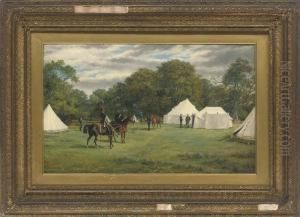A. Sheldon Williams Paintings
A. Sheldon Williams, born Alfred Sheldon Williams on May 15, 1867, in England, was a notable British painter whose work primarily focused on landscapes. He was part of a family deeply entrenched in the arts; his father, Edward Charles Williams, and his grandfather, Edward Williams, were both esteemed painters, contributing to the legacy of the Williams family in the British art scene. This lineage, often referred to as the Barnes School, was known for its distinctive landscape paintings, which Sheldon Williams embraced and carried forward in his own career.
After receiving his early training from his father, Sheldon Williams' artistic journey led him to further his education and refine his skills under the guidance of other artists and institutions, which was a common practice at the time for artists seeking to establish themselves. While specific details about his education are less documented, it is known that he worked and exhibited in England, developing a style that, while reflective of his family's influence, also sought to capture the evolving landscape genre of the late 19th and early 20th centuries. His work was characterized by detailed natural scenes, often capturing the serene beauty of the English countryside with a delicate and nuanced approach to light and color.
Throughout his career, A. Sheldon Williams exhibited at various prestigious venues, including the Royal Academy and the Royal Society of British Artists, a testament to his talent and the recognition he received from his peers and the art community. His paintings were well-received, noted for their ability to evoke the tranquil and picturesque qualities of rural England, and he gained a respectable following of collectors and enthusiasts.
Williams' contribution to the art world extended beyond his paintings. He was part of a generation of artists who transitioned from the traditional Victorian styles to more impressionistic approaches, capturing the subtle interplay of light and the vibrant essence of the landscape. Despite this, he remained somewhat anchored in the techniques and motifs that had defined his family's artistic heritage, thus serving as a bridge between the old and the new.
A. Sheldon Williams passed away on December 21, 1948. His legacy, though perhaps not as widely recognized as some of his contemporaries, remains an important part of the British art historical narrative, especially in the context of landscape painting. His works continue to be appreciated by collectors and historians, offering a glimpse into the pastoral beauty that characterized much of Britain's landscape art during his lifetime.



